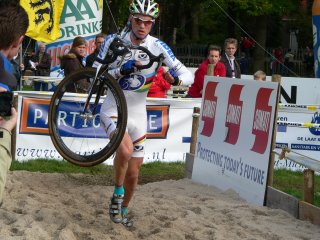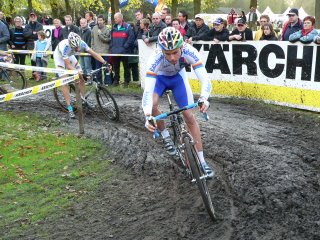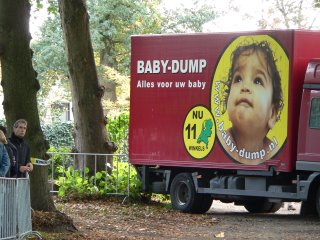What do you do the day after going to a six-day race?
Why, you go to a cyclocross race.
After the smoky night indoors in Dortmund, I needed some fresh air. It was a nice October afternoon, and I had noticed there was a professional cyclocross race in Sint-Michielsgestel, in the Netherlands, just an hour and a half drive from here.
For those who don’t know, cyclocross racing takes place on a course that is part on the road, and part off-road. There are obstacles where the riders are forced to dismount and carry their bikes. When the conditions are bad, in some places it’s faster to run than ride. They use bikes made for cyclocross: essentially a road bike that’s a little less aggressive, with wider tires and more brake clearance.
I’ve done exactly two cyclocross races in my life, and decided it wasn’t for me. I was sore for days afterwards. But then I was racing on a 35 pound mountain bike, using road pedals, and I hadn’t done any running in many years. It was as ugly as it was painful.
The race in Sint-Michielsgestel was a professional race, but it also included races for Masters, Juniors, Women, and U23’s. I parked and started to walk to the race course. I felt like I was at a local race at home. The racers from the early races were changing clothes, washing the mud off their bikes, and rehashing the race. The U23’s were warming up, sprinting and down the street.
I wanted to change, hop on my bike and jump in with them.
I watched the U23’s start and fly into the first turn off the pavement and onto the dirt, with brakes squealing, bikes crashing, and guys yelling. They quickly turned onto a small metal bridge (the sound even made me nervous), then through a field with a dismount and run through a sand pit. To say that it looked hard doesn’t begin to explain it.
The sand pit:

Cyclocross is spectator friendly. I walked the entire course watched all the difficult sections. In several places I could stand and have a 360-degree view of the race. You’re also up close to the racers, with only some plastic tape keeping you off the course. If you’re not careful and lean too far into the course, you can easily get hit.
The crowd watching the race was large – fans there for the race, families from the town, racers who had finished their races. Food and beer of course (do I need to keep mentioning that?).
The pro race had many of the top guys: Sven Nys, Bart Wellens, Richard Groenendaal, Erwin Vervecken. It’s pretty cool to see the guys in person who I’ve only read about.
They started insanely fast, with guys sprinting from the start to get to the first turn off the pavement. Now, I assumed that as professionals these guys would be good, but I could not believe the speed at which they rode on the dirt, and the skill they showed in the difficult sections of the course.
Nys over the barriers:

The race was an hour of absolute intensity. With the exception of Nys, who seemed to float over the course, they all had a look of pain on their faces. No doubt, these guys were tough. I felt bad for the guys who were at the tail end, in danger of getting lapped. They still looked like they were riding as hard as they could go.
Sven Nys won by a pretty comfortable margin. I left with a completely different perspective on ‘cross. If it wasn’t for my still-not-right collarbone, I might even be convinced to try it again.
Nys navigates the muddy section with ease:

The other guys have a harder time:

No doubt, one of the oddest sponsor names ever:








